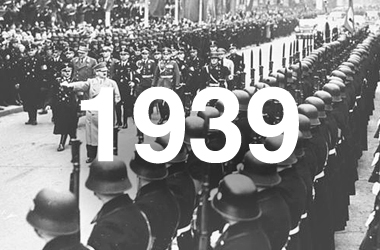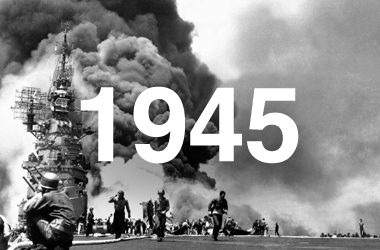World War II History Books 1945

January 9 – August 15, 1945: Battle of Luzon
In February 1944, as Japanese military advances threatened to overwhelm New Guinea, a tiny, four-pound Yorkshire Terrier was discovered hiding in the island's thick jungles. A total mystery as to her origins, she was adopted by US Army Air Force Corporal William "Bill" Wynne, an air-crewman in a photo reconnaissance squadron, becoming an irreplaceable lucky charm for the unit. When Smoky saved Wynne's life by barking a warning of an incoming kamikaze attack, he nicknamed her the "angel from a foxhole."
Smoky's exploits continued when she jumped for the unit in a specially designed parachute and famously joined the aircrews flying daring sorties in the war-torn skies. But her most heroic feat was running a cable through a seventy-foot pipe no wider than four inches in places to enable critical communication lines to be run across an airbase which had just been seized from the enemy, saving hundreds of ground-crew from being exposed to enemy bombing.
In recognition of her efforts, Smoky was awarded eight battle stars. Smoky the Brave brings to vivid life the danger and excitement of the many missions of World War II's smallest hero.
February 19 – March 26, 1945: Battle of Iwo Jima
When Admiral William Halsey selected Destroyer Squadron 21 (Desron 21) to lead his victorious ships into Tokyo Bay to accept the Japanese surrender, it was the most battle-hardened US naval squadron of the war.
But it was not the squadron of ships that had accumulated such an inspiring resume; it was the people serving aboard them. Sailors, not metallic superstructures and hulls, had won the battles and become the stuff of legend. Men like Commander Donald MacDonald, skipper of the USS O'Bannon, who became the most decorated naval officer of the Pacific war; Lieutenant Hugh Barr Miller, who survived his ship's sinking and waged a one-man battle against the enemy while stranded on a Japanese-occupied island; and Doctor Dow "Doc" Ransom, the beloved physician of the USS La Vallette, who combined a mixture of humor and medical expertise to treat his patients at sea, epitomize the sacrifices made by all the men and women of World War II.
An intimate true account of Americans at war, Days of Steel Rain is an epic drama about an unlikely group of men forced to work together in the face of an increasingly desperate enemy during the final year of World War II.
Sprawling across the Pacific, this untold story follows the crew of the newly-built "vengeance ship" USS Astoria, named after her sunken predecessor lost earlier in the war. At its center lies U.S. Navy Captain George Dyer, who vowed to return to action after suffering a horrific wound. Yet with the nation's resources and personnel stretched thin by the war, he found that just getting the ship into action would prove to be a battle. Tensions among the crew flared from the start. Astoria's sailors and Marines were a collection of replacements, retreads, and older men. Some were broken by previous traumatic combat, most had no desire to be in the war, yet all found themselves fighting an enemy more afraid of surrender than death.
Days of Steel Rain brings to life more than a decade of research and firsthand interviews, depicting with unprecedented insight the singular drama of a captain grappling with a prospective mutiny amidst some of the most brutal fighting of World War II. Throughout, Brent Jones fills the narrative with secret diaries, memoirs, letters, interpersonal conflicts, and the innermost thoughts of the Astoria men. Days of Steel Rain weaves an intimate, unforgettable portrait of leadership, heroism, endurance, and redemption.
April 30, 1945: Adolf Hitler Commits Suicide
On April 30, 1945, Hitler committed suicide in his bunker as the Red Army closed in on Berlin. Within four days the Soviets had recovered his body. But the truth about what the Russian secret services found was hidden from history, when, three months later, Stalin officially declared to Truman and Churchill that Hitler was still alive and had escaped abroad. Reckless rumors about what really happened to Hitler began to spread like wildfire and, even today, they have not been put to rest. Until now.
In 2017, after two years of painstaking negotiations with the Russian authorities, award-winning investigative journalists Jean-Christophe Brisard and Lana Parshina gained access to confidential Soviet files that finally revealed the truth behind the incredible hunt for Hitler's body.
Their investigation includes new eyewitness accounts of Hitler's final days, exclusive photographic evidence and interrogation records, and exhaustive research into the power struggle that ensued between Soviet, British, and American intelligence services. And for the first time since the end of World War II, official, cutting-edge forensic tests have been completed on the human remains recovered from the bunker graves–a piece of skull with traces of a lethal bullet, a fragment of bone, and teeth.
In April 1945, as Germany faced defeat, Hitler planned to round up the Third Reich's most valuable prisoners and send them to his "Alpine Fortress," where he and the SS would keep the hostages as they made a last stand against the Allies. The prisoners included European presidents, prime ministers, generals, British secret agents, and German anti-Nazi clerics, celebrities, and officers who had aided the July 1944 bomb plot against Hitler–and the prisoners' families. Orders were given to the SS: if the German military situation deteriorated, the prisoners were to be executed–all 139 of them.
So began a tense, deadly drama. As some prisoners plotted escape, others prepared for the inevitable, and their SS guards grew increasingly volatile, drunk, and trigger-happy as defeat loomed. As a dramatic confrontation between the SS and the Wehrmacht threatened the hostages caught in the middle, the US Army launched a frantic rescue bid to save the hostages before the axe fell.
Drawing on previously unpublished and overlooked sources, Hitler's Last Plot is the first full account of this astounding and shocking story, from the original round-up order to the prisoners' terrifying ordeal and ultimate rescue. Told in a thrilling, page-turning narrative, this is one of World War II's most fascinating episodes.
April 1 – June 22, 1945: Battle of Okinawa
On Easter Sunday, April 1, 1945, more than 184,000 US troops began landing on the only Japanese home soil invaded during the Pacific war. Just 350 miles from mainland Japan, Okinawa was to serve as a forward base for Japan's invasion in the fall of 1945.
Nearly 140,000 Japanese and auxiliary soldiers fought with suicidal tenacity from hollowed-out, fortified hills and ridges. Under constant fire and in the rain and mud, the Americans battered the defenders with artillery, aerial bombing, naval gunfire, and every infantry tool. Waves of Japanese kamikaze and conventional warplanes sank 36 warships, damaged 368 others, and killed nearly 5,000 US seamen.
When the slugfest ended after 82 days, more than 125,000 enemy soldiers lay dead–along with 7,500 US ground troops. Tragically, more than 100,000 Okinawa civilians perished while trapped between the armies. The brutal campaign persuaded US leaders to drop the atomic bomb instead of invading Japan.
Utilizing accounts by US combatants and Japanese sources, author Joseph Wheelan endows this riveting story of the war's last great battle with a compelling human dimension.
From the award-winning historian, Saul David, the riveting narrative of the heroic US troops, bonded by the brotherhood and sacrifice of war, who overcame enormous casualties to pull off the toughest invasion of WWII's Pacific Theater—and the Japanese forces who fought with tragic desperation to stop them.
With Allied forces sweeping across Europe and into Germany in the spring of 1945, one enormous challenge threatened to derail America's audacious drive to win the world back from the Nazis: Japan, the empire that had extended its reach southward across the Pacific and was renowned for the fanaticism and brutality of its fighters, who refused to surrender, even when faced with insurmountable odds. Taking down Japan would require an unrelenting attack to break its national spirit, and launching such an attack on the island empire meant building an operations base just off its shores on the island of Okinawa.
The amphibious operation to capture Okinawa was the largest of the Pacific War and the greatest air-land-sea battle in history, mobilizing 183,000 troops from Seattle, Leyte in the Philippines, and ports around the world. The campaign lasted for 83 blood-soaked days, as the fighting plumbed depths of savagery. One veteran, struggling to make sense of what he had witnessed, referred to the fighting as the "crucible of Hell." Okinawan civilians died in the tens of thousands: some were mistaken for soldiers by American troops; but as the US Marines spearheading the invasion drove further onto the island and Japanese defeat seemed inevitable, many more civilians took their own lives, some even murdering their own families. In just under three months, the world had changed irrevocably: President Franklin D. Roosevelt died; the war in Europe ended; America's appetite for an invasion of Japan had waned, spurring President Truman to use other means—ultimately atomic bombs—to end the war; and more than 250,000 servicemen and civilians on or near the island of Okinawa had lost their lives.
Drawing on archival research in the US, Japan, and the UK, and the original accounts of those who survived, Crucible of Hell tells the vivid, heart-rending story of the battle that changed not just the course of WWII, but the course of war, forever.
Sergeant Steve Maharidge returned from World War II an angry man. For a long time, the only evidence that remained of his service in the Marines was a photograph of himself and a buddy that he tacked to the basement wall. When his son, Dale Maharidge, set out to discover what happened to the friend in the photograph, he found that wars do not end when the guns go quiet. The scars and demons remain for decades.
Bringing Mulligan Home is the book on which the hit Amazon Audible Original, The Dead Drink First, is based. Years after the initial publication of the book, Dale Maharidge and an ad-hoc team of committed researchers kept working to bring closure for Sgt. Maharidge, his family, and his mysterious friend. For fans of The Dead Drink First, this newly updated edition enriches and deepens the experience of the Audible Original, and provides—for the first time in print—a resolution to Maharidge's story of fathers and sons, war and the long oft-forgotten postwar for America's Greatest Generation.
May 23, 1945: Heinrich Himmler Commits Suicide
The Waffen-SS was one of the most feared combat organizations of the twentieth century. Originally formed as a protection squad for Adolf Hitler it became the military wing of Heinrich Himmler's SS and a key part of the Nazi state, with nearly 900,000 men passing through its ranks. The Waffen-SS played a crucial role in furthering the aims of the Third Reich which made its soldiers Hitler's political operatives. During its short history, the elite military divisions of the Waffen-SS acquired a reputation for excellence, but their famous battlefield record of success was matched by their repeated and infamous atrocities against both soldiers and civilians.
Waffen-SS is the first definitive single-volume military history of the Waffen-SS in more than 50 years. In considering the actions of its leading personalities, including Himmler, Sepp Dietrich, and Otto Skorzeny, and analyzing its specialist training and ideological outlook, eminent historian Adrian Gilbert chronicles the battles and campaigns that brought the Waffen-SS both fame and infamy.
August 15 – August 18, 1945: Final Air Missions of Pacific Campaign
From an expert in the Pacific theater of World War II comes the tragic story of the pilots who fought the last fight of the war during the first hour of peace.
When Billy Hobbs and his fellow Hellcat aviators from Air Group 88 lifted off from the venerable Navy carrier USS Yorktown early on the morning of August 15, 1945, they had no idea they were about to carry out the final air mission of World War II. Two hours later, Yorktown received word from Admiral Nimitz that the war had ended and that all offensive operations should cease. As they were turning back, twenty Japanese planes suddenly dove from the sky above them and began a ferocious attack. Four American pilots never returned--men who had lifted off from the carrier in wartime but were shot down during peacetime.
Drawing on participant letters, diaries, and interviews, newspaper and radio accounts, and previously untapped archival records, historian and prolific author of acclaimed Pacific theater books, including Tin Can Titans and Hell from the Heavens, John Wukovits tells the story of Air Group 88's pilots and crew through their eyes. Dogfight over Tokyo is written in the same riveting, edge-of-your-seat style that has made Wukovits's previous books so successful. This is a stirring, one-of-a-kind tale of naval encounters and the last dogfight of the war—a story that is both inspirational and tragic.
An aerial gunner who had already survived several combat missions, Marchione's death was the tragic culmination of an intertwined series of events. The plane that carried him that day was a trouble-plagued American heavy bomber known as the B-32 Dominator, which would prove a failed competitor to the famed B-29 Superfortress. And on the ground below, a palace revolt was brewing and a small number of die-hard Japanese fighter pilots decided to fight on, refusing to accept defeat.
Based on official American and Japanese histories, personal memoirs, and the author's exclusive interviews with many of the story's key participants, Last to Die is a rousing tale of air combat, bravery, cowardice, hubris, and determination, all set during the turbulent and confusing final days of World War II.
November 20, 1945 – October 1, 1946: Nuremberg Trials
By clicking ‘Sign Up,’ I acknowledge that I have read and agree to Hachette Book Group’s Privacy Policy and Terms of Use
Explore More World War II History Books




















